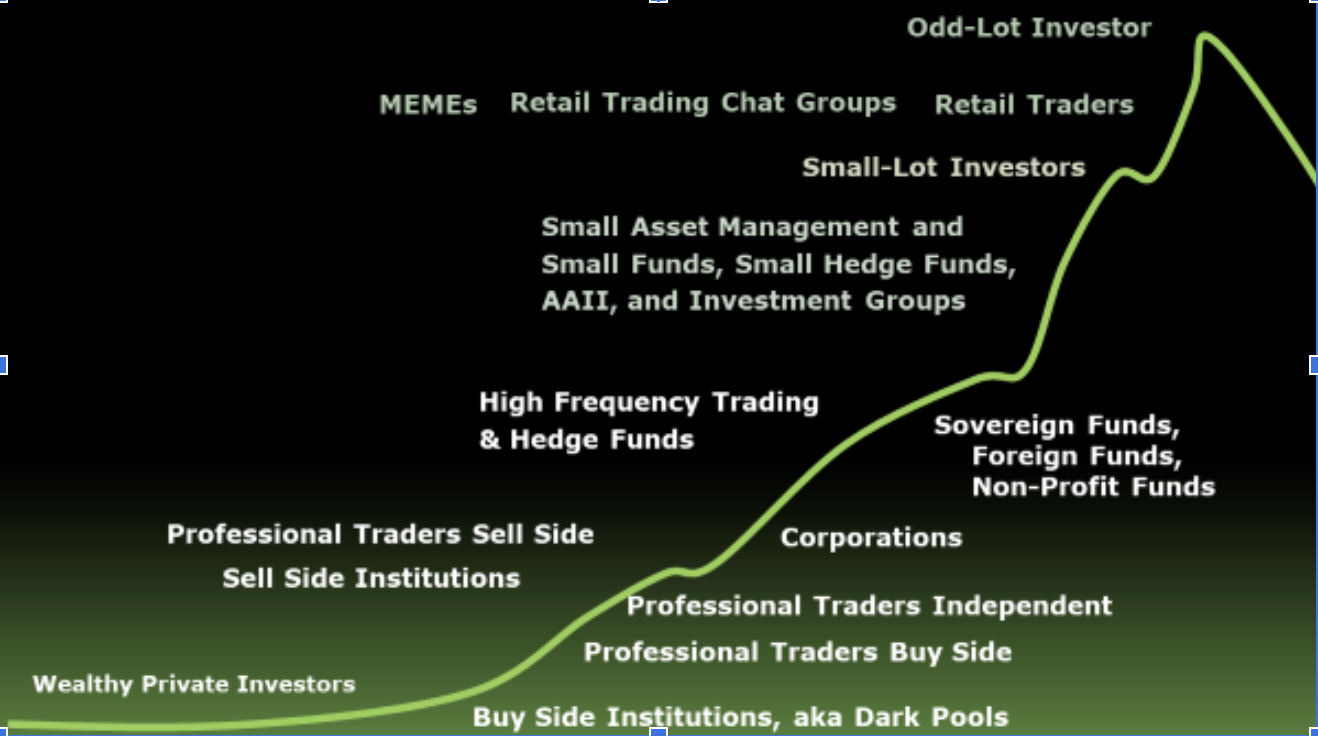–News Direct–
Whenever the retail news talks about Wall Street vs. Main Street, I just chuckle. Wall Street vs. Main Street is long gone. The new market structure is entirely different now, with exciting new opportunities for retail traders and investors.
The term Wall Street referred to the giant Sell-Side Institutions, the big banks and investment firms which once dominated the market. Big banks were the power and money behind most transactions. That dominance ended in 2008 with the banking debacle of that era. Wall Street has never been the same. Banks are struggling.
Should you be worried?
No. What you should be focused on are the Giant Buy-Side Institutions, which I call the Dark Pools since they transact orders on hidden Dark Pool venues. They are now the dominant force behind the scenes. They create a slow but massive liquidity draw when millions of shares of stock are bought slowly over time. This creates a huge hidden opportunity for both retail traders and investors.
The Big Banks are always in the news. Not so with the Dark Pools, but they control 130 trillion dollars of assets under management worldwide.
While the big banks revenue growth is eroding due to the growth of crypto currencies and all the variables of blockchain technology, the Dark Pools have been buying up huge quantities of the top crypto currencies to create new ETFs and other new investment and trading products. They are already making huge profits on these new derivatives.
Peer-to-Peer transactions are growing in popularity. The banks role as intermediaries, as vital and necessary to the global monetary system, is in question. When all transactions are digital and the use of virtual wallets is the new normal, will we need banks as intermediaries for transactions between corporations, small businesses, consumers or government? Meanwhile, the Dark Pools manage the vast majority of 401(k)s and other retirement accounts. THEY are vital to the stability of the middle class of America.
The Giant Buy-Side Institutions are usurping the big banks profitability from underwriting IPOs. The NASDAQ Private Market (NPM) is a new professionals-only stock market exchange where Buy-Side Institutions can invest in private companies much earlier in the cycle.
Banks are no longer in control of which private companies will IPO, as the Buy-Side Institutions invest in these private companies via the NPM before they go public. Banks will experience a sharp reduction of profit from underwriting IPOs because the Buy-Side Institutions used to be their Preferred Clients, who bought shares of stock directly from the banks, which sold the majority of the shares to the Buy-Side Institutions well ahead of the IPO date.
Banks are still used by most corporations for corporate buybacks of shares of a companys public stock, but even that may end soon as new-technology financial companies, hedge funds and other firms can offer trading floor transactions instead of using the Bank of Record for buybacks. Or, the corporations may hire highly skilled traders and use AI as a means of managing buybacks.
So Wall Street, aka giant banks and financial services, is not the force driving the huge growth of the stock market. This is an irreversible condition of an evolving global financial system.
There is no Main Street. The millions of Americans who trade or invest in stocks are not one mindless group all behaving the same way. Each group trades and invests in a totally different way. This affects how stock prices move.
-
Retail Long Term Investors. The SEC estimates about 70 million FAMILIES have invested in the stock market. As long-term investors, they are usually profitable. They have experience and some basic market knowledge.
-
Retail Traders. This group is mostly trying to day trade, so they lose more money than any other group. They are largely gamblers and speculators with minimal market experience.
-
Semi-Professional Traders. These individuals Trade as a Business full-time, similarly to independent professional traders. They have IRS business status for tax purposes.
-
Smaller Funds Managers. These companies or individuals work with less than $3 billion in assets under management to as small as $100,000. They are considered retail as they lack experience or knowledge and tend to react to news similarly. They are no longer required to file SEC reports.
-
MEME stock trading groups. This is a large group of higher-income younger-generation investors and traders who follow a retail-side guru. They trade the same meme stocks all at once to move the market deliberately in huge swings of price.

Stock Market Cycle of Market Participants from TechniTrader
Thinking in terms of us vs. them is not the right attitude for successful trading in the financial markets. With a better understanding of the market participantstheir goals, knowledge level, hold duration, how they trade, etc.a well-educated trader or investor can identify when they are active and follow the market participant that best aligns with their goals. This is why I created the stock analysis method called Relational Technical Analysis, which is based on the Cycle of Market Participants. Visit my website to learn more.
Martha Stokes, CMT
https://www.technitrader.courses/
This post was authored by an external contributor and does not represent Benzinga's opinions and has not been edited for content. This contains sponsored content and is for informational purposes only and not intended to be investing advice.
Contact Details
Benzinga
+1 877-440-9464
Company Website
View source version on newsdirect.com: https://newsdirect.com/news/rip-wall-street-vs-main-street-449507678
Benzinga
COMTEX_440676023/2655/2023-09-21T17:01:47
Disclaimer: The views, suggestions, and opinions expressed here are the sole responsibility of the experts. No Smart Herald journalist was involved in the writing and production of this article.